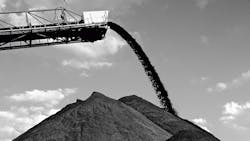Troubleshooting Challenge: Hydraulic Motor Presents Problem on Coal Conveyor
The electric motor was rated at 15 hp at 1,800 rpm and supplied with 440 Vac, three phase, 60 Hz. Input speed to the conveyor’s gearbox was 1,800 rpm, so the electric motor used a belt drive with a 1:1 speed ratio. At full pressure, the hydraulic motor transmitted 18 hp at 900 rpm, so it used a 2:1 belt drive in order to provide the 1,800-rpm input speed to the conveyor. This gave a 20% safety factor for efficiency loss.
The conveyor ran well with the 15-hp electric motor, and the hydraulic motor was able to run the conveyor when it was empty. However, when the conveyor was loaded and stopped at the end of the work shift, the hydraulic motor could not start and run the conveyor.
All the math was checked and no error was found. So why was the electric motor able to power the conveyor, but the hydraulic motor wasn’t?
Find the solutionThink you know the answer? You can submit solutions by e-mailing [email protected]. All correct solutions will be entered for a chance at a $50 gift card — we will randomly select a winner from all correct submissions. The winner will be notified and his or her name will be printed in a future issue. Congratulations to Paul Lopez, CFPS, of Michaelson Fluid Power Inc., Smithfield, R.I., whose name was drawn at random from those who correctly answered May’s “Troubleshooting Challenge.” |
About the Author
Robert Sheaf
President
Robert J. Sheaf Jr., is the founder and president of CFC Industrial Training, formerly Certified Fluid Consultants, part of CFC-Solar Inc. CFC-Solar provides technical training, consulting, and field services to any industry using fluid power technology.

Leaders relevant to this article:

